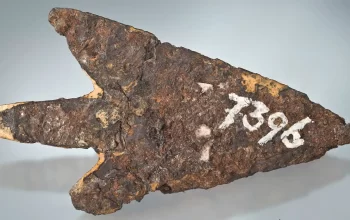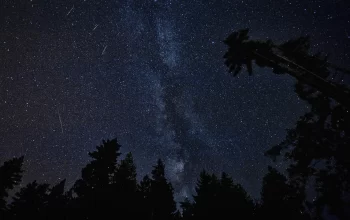
Scientists have discovered an ancient meteorite crater in the vineyard of a winery in the south of France.
Our planet has been bombarded by celestial bodies and meteorites since the first moment of its formation. While some of these meteorites disappear while still in the atmosphere, some can reach the earth and shape geographical landforms. For example, some gulfs were formed in this way. In fact, considering the Cretaceous-Paleogene extinction, it can even be said that some meteorites had an impact on biological evolution.
According to NASA, a car-sized meteorite enters the Earth’s atmosphere about once a year, but most meteorites smaller than 25 meters (82ft) burn up before they reach Earth’s surface.1
Therefore, it can be said that a meteorite that wants to reach the surface of the Earth must be larger than 25 meters.

Photo: Frank Brenker, Goethe University Frankfurt (Johann Wolfgang Goethe-Universität Frankfurt am Main)
If a large space rock traveling in the Solar System is caught in the Earth’s gravity or its orbit coincides with that of the Earth, it will start to burn with the effect of friction as soon as it enters the atmosphere. But what remains of it is enough to form craters on the earth. And that’s what happened centuries ago in the vineyard that now belongs to a winery in the south of France.
Located in the Hérault department of the Occitania region, the winery has actually been using the motto “wines from another dimension” humorously for years. Because in the 1950s, a few scientists suggested that the round depression in the region was a meteorite crater. However, this hypothesis was dismissed and was not discussed for many years. Until the crater caught Frank Brenker’s attention…
Not long ago, Frank Brenker, a professor of cosmochemistry and nanogeoscience, traveled to Béziers together with Andreas Junge, a professor of geophysics, to study the crater. The location of the crater is below:
First, it was determined that the Earth’s magnetic field is weaker in the crater, which is about 200 meters (656ft) wide. Also, many tiny iron oxide spherules, that are hard to spot at first glance, and microdiamonds have been found in the area. Microdiamonds are thought to have formed through high pressure during impact. In some meteorite types, the high pressure shock waves produced by the collision can form diamonds.2
In addition, dark layers that could be shock veins were detected in many rock samples collected from the crater and examined in laboratories.
According to the study, all this confirms that the crater was formed as a result of impact.
15-Question Quiz Full of Surprising Facts for Astronomy and Space Enthusiasts
Impact Craters
Craters caused by meteorites falling to the earth, if they are not excessively large, may become invisible over time due to geomorphological processes such as erosion.
There are currently 190 confirmed impact craters on Earth, according to the Earth Impact Database, managed by John Spray, director of the Planetary and Space Science Center at the University of New Brunswick.3
The closest impact craters to the Hérault department are the Rochechouart crater in France and the Steinheim and Nördlinger Ries craters in Germany.
According to the Earth Impact Database, as of February 25, 2023, there are 30 confirmed impact craters in the USA, 32 in Canada, 42 in Europe, 30 in Australia and 3 in India.
External Links
- Domaine du Météore (Official Website)
- Earth Impact Database (World Map)
- “Asteroid Fast Facts“, National Aeronautics and Space Administration, nasa.gov, Mar 31, 2014, Last Updated: Aug 7, 2017[↩]
- “Impact shock origin of diamonds in ureilite meteorites“, September 28, 2020, Vol: 117, No: 41, 205310-25318[↩]
- “About the Earth Impact Database“, Earth Impact Database, Planetary and Space Science Centre, UNB[↩]



